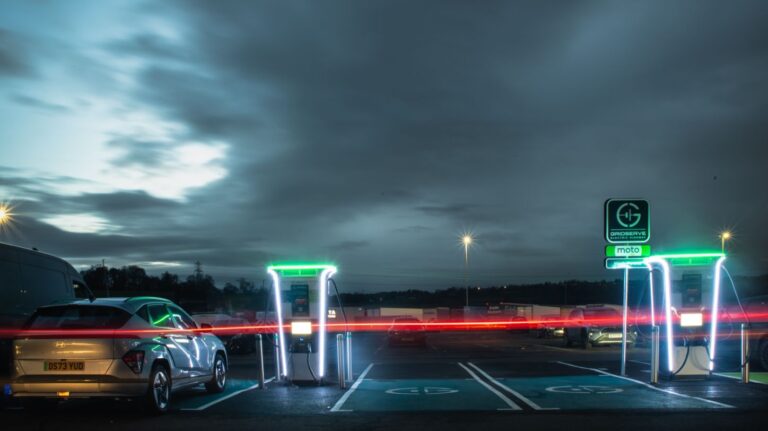As the UK accelerates toward an electric vehicle dominated future, the nation faces formidable challenges in establishing an equitable and efficient charging infrastructure…
With the UK government setting ambitious targets to phase out new petrol and diesel vehicles by 2035, if not 2030, the transition to electric vehicles (EVs) is not just a preference but a necessity. Yet, the path to widespread adoption is riddled with obstacles that require a collaborative effort from the public and private sectors. Equitable access to EV charging infrastructure is regarded by many as crucial for achieving the UK’s climate goals.
However, as Sharon McDermott, managing director at Trenches Law, points out, significant disparities remain. “The current infrastructure does not adequately serve fleet vehicles, which are increasingly transitioning to electric. Many fleet vehicles are no longer housed in centralised depots but are kept at employees’ homes, creating logistical challenges for charging, particularly for those living in flats or areas without designated charging points. This lack of infrastructure not only hampers the adoption of
EVs among fleet operators but also affects residents in multi-dwelling units, who may face complex permissions-related challenges when attempting to install charging points.”
FAST FACT: As of July 2024, Scotland has the highest provision of ultra-rapid charging devices per 100,000 people, with 26.1 devices. Source: UK DfT
Moreover, the issue of equitable access extends to the general public. While the UK government has committed £1.6bn in public funding for charging points, the general perception is that current infrastructure is often inaccessible, inconvenient or unreliable, particularly in rural areas.
As Rolf Bienert, technical and managing director at the OpenADR Alliance, notes, the UK requires charging infrastructure that is “fit for purpose”, with easy-to-find chargepoints, clear pricing structures, and reliable availability. “Without these improvements, public confidence in EVs will remain low, stalling the transition to a zero-emission future.”
Public-private partnership
Thus, expanding access to EV charging infrastructure likely requires a coordinated effort between the public and private sectors. Asif Ghafoor, CEO of chargepoint operator (CPO) Be.EV, highlights the inefficiencies in the current system, where local authorities, despite receiving funding through the Local Electric Vehicle Investment (LEVI) fund, often lack the expertise to effectively roll out charging infrastructure.
“This has led to the installation of slow lamppost chargers, which, given the rapid evolution of battery technology, may become obsolete within a few years,” says Ghafoor, who advocates for a model where local authorities delegate the rollout of charging infrastructure to private sector operators who have the expertise and resources to deliver more effective solutions.
Ghafoor cites the success of Trafford Council, in Manchester, which partnered with Be.EV to increase the number of rapid and ultra-rapid charge points in the area. “In January 2021, the area had close to zero effective chargepoints per 100,000 residents – will below the national average of 20. By last year, Trafford had 50 rapid and ultra-rapid chargerpoints per 100,000 – nearly triple the national average.
Be.EV’s knowledge of the local areas meant the company knew which sites had the necessary power, starting with local authority car parks, before expanding to leisure centres, libraries and onto private land. “All Trafford Council needed
to do was give permission and explain the ideas to private landlords. This worked a treat.”
According to Ghafoor, this public-private partnership model could be replicated across the UK, accelerating the deployment of charging infrastructure and ensuring it meets the needs of all users.
But for local authorities to effectively contribute to the development of EV charging infrastructure, they must invest in upskilling their workforce. Alistair Watson, partner and UK head of planning and environment at law firm Taylor Wessing, stresses the importance of the draft National Planning Policy Framework (NPPF), which integrates EV hubs into broader logistics and transport strategy.
“Local authorities must work closely with private developers to identify suitable sites
for EV hubs, streamline the planning process, and ensure that these developments are sustainable and aligned with net-zero targets,” says Watson.
“The planning process itself offers opportunities for upskilling, as it involves a range of consultancy skills, including design, energy management, and transport planning,” he continues. “By fostering collaboration between public and private sectors, the NPPF can serve as a catalyst for developing the expertise needed to deliver EV infrastructure at scale.”
However, the complexity of the EV ecosystem also necessitates a strategic approach to procurement. Dario Feliciangeli, transport market lead at professional services firm GHD, underscores the importance of aligning procurement processes with long-term infrastructure goals: “This involves active engagement between the public and private sectors to identify the most effective delivery methods, optimise supply chains, and incorporate innovative digital tools that enhance efficiency and sustainability.
“Strategic procurement not only helps navigate economic uncertainty but also ensures that infrastructure projects are delivered on time and within budget,” continues Feliciangeli. “By leveraging data-driven decision-making, local authorities and private developers can create a robust EV charging network that meets the demands of an increasingly electrified transport sector.
Collaborative efforts
The transition to electric fleets also presents unique challenges, particularly in terms of charging infrastructure. Mike Brown, vice president of product at e-fleets solution provider VEV, highlights the need for “green corridors” – networks of shared charging hubs along major transport routes: “These corridors are essential for reducing scope 3 emissions and enabling the widespread adoption of electric heavy goods vehicles,” he explains.
“However, developing these corridors requires significant up-front investment and careful planning to ensure that the infrastructure can accommodate the high-power demands of commercial vehicles,” states Brown. “Collaborations between transport operators, energy providers, and government agencies are crucial to overcoming these challenges and building a charging network that supports the needs of commercial fleets.
Public confidence in EVs is another critical factor in the success of the transition.” According to Bienert, building confidence requires both certainty in government policies and the availability of reliable charging infrastructure: “The UK’s political flip-flopping on the phase-out date for petrol and diesel cars has created uncertainty among consumers, leading to a decline in private EV purchases. To reverse this trend, the government must provide clear and consistent policies that support the EV market.”
In addition to policy certainty, Bienert believes the technology must also be in place to support widespread EV adoption. This includes making charging points easy to find, ensuring they are reliable and accessible, and providing transparent pricing information.
Forecasting demand
But that’s not all. According to Jamil Ahmed, engineer at IT services and consultancy Solace, accurately forecasting demand for EV charging infrastructure is essential to avoid bottlenecks and ensure that the network can accommodate future growth. He emphasises the importance of real-time data in resolving the challenges of ‘charge anxiety’ – the fear that drivers will not be able to find available charging points when needed.
“By implementing event-driven architecture and real-time instrumentation, governments and EV manufacturers can provide drivers with up-to-date information on charging point availability, helping to build trust in the system,” says Ahmed.
“The UK’s political flip-flopping on the phase-out date for petrol and diesel cars has created uncertainty among consumers, leading to a decline in private EV purchases” – Rolf Bienert, technical and managing director – OpenADR Alliance
Matt Croucher, chief commercial officer at EV CPO Believ, builds on Ahmed’s comments, adding that forecasting demand requires a combination of advanced data modelling and human expertise: “By using data-rich tools to predict localised demand, and supplementing this with insights from experienced planners, CPOs can ensure that the right charging solutions are installed in the right locations. This approach not only improves the efficiency of the charging network but also future-proofs it against changing needs.”
Still, the electrification of the UK’s strategic road network presents several other challenges to overcome. For example, Paul Comer, director of EV implementation at Roadchef, identifies the investment in power distribution networks as one of the biggest hurdles. He believes a coordinated approach is needed to integrate power requirements, demand profiles and long-term growth projections into
the planning and development of EV charging infrastructure.
FAST FACT: As of July 2024, the UK had 66,779 public EV charging devices across 34,570 locations, representing a 46% y-o-y increase. Source: Zap-Map
And yet, despite these challenges, Comer says there is a significant opportunity to unlock new revenue streams and drive economic growth by partnering with the government and local authorities to deliver a comprehensive charging network. “The UK’s Rapid Charging Fund pilot [which aims to accelerate the delivery of future-proofed connections at motorway service areas, where connection costs are a barrier to meeting EV charging demand] is a positive step in this direction, providing the necessary financial support to overcome the high costs of connecting remote motorway locations to the grid. However, close collaboration across industries is essential to maintaining momentum and ensuring that the infrastructure is in place to support the growing number of EVs on the road.”
Don’t stop innovating
The EV transition is undoubtedly one of the most significant challenges facing the UK today, but it also presents a unique opportunity to reshape the nation’s transport infrastructure for the better. Achieving this will require a concerted effort from all stakeholders – government, local authorities, private developers, and the public, addressing the challenges of equitable access, strategic procurement, fleet electrification, and public confidence.
However, the importance of innovation in EV infrastructure cannot be overstated. The rapid pace of technological advancement in battery design, charging speed, and energy management systems means that today’s solutions may not be sufficient to meet tomorrow’s demands. This makes future-proofing infrastructure a critical consideration for all stakeholders.
Emerging technologies, such as wireless charging, vehicle-to-grid capabilities, and AI-driven energy management systems, offer exciting possibilities for the next generation of EV infrastructure. However, integrating these technologies into the existing grid and ensuring they are accessible to all will require significant investment and forward-thinking policies. As Watson states, “local authorities and private developers must stay ahead of these trends, incorporating flexibility into their planning processes to accommodate future innovations”.
The potential for renewable energy integration into EV charging networks is another avenue ripe for exploration. According to Brown, on-site solar generation, coupled with battery storage, can create microgrids that reduce reliance on the national grid and increase the resilience of the charging network. “This not only aligns with broader decarbonisation goals but also presents opportunities for cost savings and energy independence at a local level.”
Ultimately, the success of the UK’s transition to EVs will depend on its ability to embrace innovation while maintaining a clear focus on equity, accessibility and collaboration. If it does this, the UK may just create a sustainable, resilient, and future-proof EV charging infrastructure that meets the needs of all its citizens and sets a global standard for others to follow.
This article was originally published in the September 2024 issue of CiTTi Magazine.
Achievements and innovations in EV charging infrastructure will be celebrated at the third annual CiTTi Awards, which will be held on 26 November 2024 at De Vere Grand Connaught Rooms in London. Please visit www.cittiawards.co.uk to learn more about this unmissable event for the UK’s transportation sector – and to book your table!






